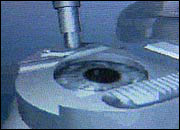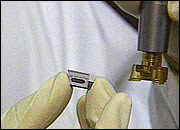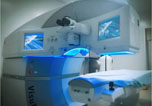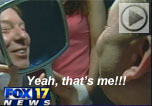- Over 55,000 LASIK and cataract procedures (including on over 4,000 doctors)
- The FIRST center in TN to offer Laser Cataract Surgery
- Introduced bladeless all-laser LASIK to the state
- Implanted the state's first FOREVER YOUNG™ Lens
- The first surgeons in the US to perform a new Intacs surgery to treat keratoconus
- Helped patients from 40 states and 55 countries
- International referral center for cataract surgery and LASIK complications
- Read Dr. Wang's book: LASIK Vision Correction
Why did you decide to have LASIK? Why did you choose Dr. Wang? How has your life changed since your LASIK procedure?
What is your advice for people considering LASIK?
Click to read more
| Article Library | Print This Page |
LASIK Surgery
Wang Vision 3D Cataract and LASIK Center, Nashville, Tennessee
Bladeless Lasik takes fear out of popular vision correction surgery
Carole Houser, RN

|
 |
For people with certain vision problems, Lasik surgery has become one of the most popular procedures available, and the latest technology might help even more people decide to take the dive and get Lasik.
Normally before a laser can correct your vision, a little blade has to do a little cutting first. That's called cutting the flap. If that doesn't sound nice, you'll like this latest development.
A little cutting device, much like a razor, is the first part of Lasik surgery. It's used to cut the flap. That part sometimes surprises and alarms patients. Dr. Ming Wang, who's used the knife for years says it is the touchiest part of Lasik.
"As you know, majority of vision threatening complications and majority of lawsuits in Lasik, come from this mechanical part the manual art of the procedure," said Dr. Wang.
Even Dr. Walter Buyanton, who knows success rates are extremely high, held off getting Lasik, because of the blade.
"Ah, a little bit reluctant to have that done I like the thought of the new bladeless surgery," said Dr. Buyanton.
Bladeless Lasik uses a new kind of laser to cut the flap. No knives involved. Buyanton says that amounts to less fear for him.
"Reduces basically the human error I believe and some of the thought of having the blade put to your eye, heh-heh," said Dr. Buyanton.
In Bladeless Lasik, the first laser beam passes through the top and vaporizes a tiny layer in the middle of the cornea -- spot, by spot, row by row. It all takes less than a minute and no risk of tearing, or infection. And, it's ten times more accurate than the blade. But how does it feel? We talked with Dr. Buyanton right after his 10 minute procedure.
"The first part of the procedure there was a little bit more pressure on each eye than I had anticipated, but that was less than a minute and the rest of it was a piece of cake," said Buyanton.
Our new texbooks
A 501c(3) charity that has helped patients from over 40 states in the US and 55 countries, with all sight restoration surgeries performed free-of-charge.




















